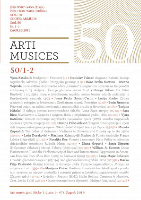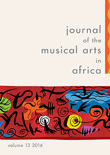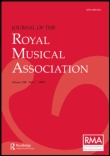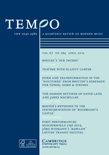
DOWN BEAT
Scope & Guideline
Transcending Boundaries in Music Research
Introduction
Aims and Scopes
- Jazz History and Analysis:
The journal features in-depth articles that explore the historical evolution of jazz, its key figures, and influential movements, providing critical insights into the genre's development. - Artist Profiles and Interviews:
DOWN BEAT regularly publishes profiles and interviews with contemporary and historical jazz musicians, offering readers a closer look at their artistic processes and contributions to the genre. - Jazz Education and Pedagogy:
The journal addresses educational topics related to jazz, including teaching methods, curriculum development, and the role of jazz education in fostering musical talent among younger generations. - Cultural Context and Social Issues:
Articles often discuss the intersection of jazz with cultural and social issues, examining how the genre reflects and influences societal changes, particularly in relation to race and identity. - Music Reviews and Critiques:
DOWN BEAT provides critical reviews of new jazz albums, performances, and festivals, helping audiences navigate the vast array of contemporary jazz offerings.
Trending and Emerging
- Diversity and Inclusion in Jazz:
There is a growing emphasis on representation and the contributions of underrepresented groups in jazz, including women and artists of color, reflecting broader societal movements for equity. - Fusion Genres and Cross-Genre Collaborations:
The journal highlights the increasing popularity of fusion genres that blend jazz with hip-hop, electronic music, and world music, showcasing innovative collaborations that push the boundaries of traditional jazz. - Mental Health and Wellbeing in Music:
Emerging discussions focus on the mental health challenges faced by musicians, with a growing recognition of the importance of mental wellness in the creative process. - Environmental and Social Justice Themes:
Articles are increasingly addressing how jazz intersects with environmental issues and social justice, exploring how artists use their platform to advocate for change. - Technological Advancements in Music Creation:
There is a rising interest in how technology influences jazz creation and performance, including the use of digital tools for composition and collaboration in remote settings.
Declining or Waning
- Traditional Jazz Styles:
There seems to be a waning interest in traditional jazz styles, such as Dixieland and swing, as contemporary forms and fusion genres gain traction among both artists and audiences. - Jazz Record Labels and Industry Analysis:
Discussions that critically analyze the role of record labels in promoting jazz have decreased, possibly due to the rise of independent releases and digital distribution channels. - Jazz Festivals and Events Coverage:
Coverage of specific jazz festivals and events has become less frequent, possibly reflecting the impact of the COVID-19 pandemic on live performances and gatherings. - Historical Jazz Recordings:
There appears to be a diminishing focus on reissues and retrospectives of historical jazz recordings, with less emphasis on archival content as contemporary releases take precedence. - Jazz Instrument Technology:
There is a noticeable decline in articles discussing innovations in jazz instrument technology, which were previously a staple in discussions about the evolution of jazz performance.
Similar Journals

Arti Musices
Exploring the Rich Tapestry of Music and HumanitiesArti Musices is a distinguished open-access journal published by the Croatian Musicological Society since 2007, dedicated to advancing the field of musicology and related arts and humanities disciplines. Operating from Zagreb, Croatia, this journal aims to provide a platform for scholarly communication, fostering international dialogue among researchers, musicologists, and practitioners. Although it has a current Scopus ranking in the bottom quartile within its category (Q4 in Music), it offers a unique perspective on the musicological landscape, particularly from a regional standpoint. Researchers seeking to contribute to or glean insights from this evolving field will find that Arti Musices serves an important role in disseminating innovative ideas and empirical research. The journal accepts submissions across a broad spectrum of music-related topics, inviting contributions that reflect the complexities and cultural contexts of music today.

Journal of Historical Research in Music Education
Advancing Insights into Music's Educational LegacyThe Journal of Historical Research in Music Education, published by SAGE Publications Inc, stands as a vital resource dedicated to advancing the understanding of the intersection between music education and historical scholarship. With ISSN 1536-6006 and E-ISSN 2328-2525, this journal serves as a beacon for researchers, educators, and students interested in exploring the influences and developments in music education from a historical perspective. Although classified in the Q4 quartile across the fields of Education, History, and Music, and while it ranks lower in the Scopus rankings (e.g., #969 in History), the journal remains committed to shedding light on significant yet often overlooked historical contexts in music education. The journal's scope from 2015 to 2024 emphasizes contemporary interests and challenges faced in the field, encouraging the dissemination of innovative research. As an essential repository of knowledge, the journal invites submissions that critically engage with historical perspectives, ensuring that the narratives of music education continue to resonate within and beyond academic circles.

Jazz Research Journal
Fostering Scholarly Discourse in the World of JazzJazz Research Journal is a premier academic publication dedicated to advancing the field of jazz studies. Published by EQUINOX PUBLISHING LTD in the United Kingdom, this journal serves as a vital platform for scholars and practitioners alike, aiming to foster dialogue and research in the rich tapestry of jazz history, theory, and practice. With an ISSN of 1753-8637 and an E-ISSN of 1753-8645, the journal has established its presence in the academic community, focusing on innovative research that showcases jazz as a dynamic and evolving art form. Although currently classified in the Q4 category of music within the Scopus rankings, the journal aspires to elevate its standing by publishing cutting-edge research that challenges conventional perspectives and contributes to a deeper understanding of jazz culture. Accessible from 2017 to 2023, the journal acts as a vital resource for researchers, professionals, and students passionate about music studies, particularly in jazz, offering a comprehensive space for groundbreaking inquiry and scholarly discourse.

Journal of the Musical Arts in Africa
Illuminating Africa's Musical TapestryThe Journal of the Musical Arts in Africa is a premier academic publication dedicated to exploring the rich and diverse musical traditions of the African continent. Published by ROUTLEDGE JOURNALS, TAYLOR & FRANCIS LTD, this journal offers a vital platform for researchers, professionals, and students in the field of musicology. With an ISSN of 1812-1004 and E-ISSN of 2070-626X, the journal has established itself as a significant contributor to the scholarly discourse surrounding African musical practices. With an impact factor reflecting its growing influence, the Journal of the Musical Arts in Africa is categorized in the Q3 quartile of music journals according to the latest metrics, placing it among an essential cadre of publications in the field. The journal invites original research articles, reviews, and critical essays that aim to expand the understanding of music as an integral part of African culture. It has been continuously publishing since 2004 and encompasses a wide range of topics, making it a must-read for anyone interested in the intersections of music, culture, and identity on the African continent. The journal stands as a testament to the vibrant musical heritage of Africa and encourages scholarly contributions that highlight the importance of music in reflecting and shaping societal values.

MUSIK UND KIRCHE
Bridging Sacred Melodies and Spiritual InsightsMUSIK UND KIRCHE is a distinguished journal published by BARENREITER-VERLAG that offers a scholarly platform for the exploration of the intersections between music and ecclesiastical contexts. With an ISSN of 0027-4771 and an E-ISSN of 2568-3128, this journal is particularly valuable for researchers, practitioners, and students engaged in musicology, religious studies, and cultural history. Although currently not open access, it provides a wealth of peer-reviewed articles that enhance understanding of music's role within church tradition and practice, thereby contributing significantly to the field. Despite fluctuating visibility in academic rankings—standing in Q4 of the 2023 category for Music, based on Scopus evaluations—its historical coverage from 2002 to 2012 and resumed publication since 2020 demonstrates its commitment to fostering rigorous academic discourse. The journal is based in Kassel, Germany, and serves as an essential resource for anyone interested in the dynamic relationship between music and spiritual life.

JOURNAL OF THE ROYAL MUSICAL ASSOCIATION
Illuminating the rich tapestry of musical history.JOURNAL OF THE ROYAL MUSICAL ASSOCIATION, published by Cambridge University Press, stands as a significant repository for innovative research and scholarly discourse within the field of music studies. Recognized for its contributions to the understanding of musical practices, theory, and history, this esteemed journal offers a platform for academics and researchers to disseminate their findings to a broad audience. With an ISSN of 0269-0403 and E-ISSN of 1471-6933, the journal has maintained a notable presence since its inception, merging insights from both traditional and contemporary musicology. It currently occupies a Q4 ranking in Music within the Scopus database, reflecting its inclusion within the arts and humanities landscape. While the journal traditionally operates under subscription access, its continuing commitment to advancing music scholarship ensures that it remains an essential resource for students, scholars, and practitioners alike, fostering greater understanding and appreciation of musical artistry from 1987 to the current era.

TEMPO
Pioneering Critical Conversations in Music ResearchTEMPO, a renowned journal published by Cambridge University Press, is dedicated to the expansive field of music studies. With its rich history dating back to 1939, the journal has significantly evolved, offering researchers, professionals, and students a platform to explore diverse musical perspectives and innovations. Serving as a vital resource in its category, TEMPO is currently positioned in the Q2 quartile within the field of Music, reflecting its quality and academic influence. Although it operates under a traditional subscription model, its impactful contributions to music scholarship are underscored by its active engagement with contemporary issues in musicology, performance, and education. Researchers can rely on TEMPO for cutting-edge analyses, reviews, and critical discourse that shape the understanding of music in society.

REVUE DE MUSICOLOGIE
Advancing Research in the World of MusicREVUE DE MUSICOLOGIE is a prominent academic journal dedicated to the diverse field of musicology, published by EDITIONS TRANSATLANTIQUES in France. With an ISSN of 0035-1601, this journal has been a key platform for researchers and scholars since its inception, fostering scholarly discourse and advancing the understanding of music's cultural, theoretical, and historical dimensions. Although it currently holds a Q4 category in Music according to the 2023 quartiles and is ranked #140 in the Scopus Arts and Humanities Music category, REVUE DE MUSICOLOGIE continues to publish valuable insights that contribute to the global musicological landscape. The journal does not offer open access, adhering to standard subscription models. Its primary objective is to provide a rigorous forum for original research articles, reviews, and theoretical discussions, making it an essential resource for academics, professionals, and students in the field of musicology. Located at 50 RUE JOSEPH DE MAISTRE, 75018 PARIS, FRANCE, it promises to remain a vital part of music research through 2023 and beyond.

Opus
Bridging Theory and Practice in Music ResearchOpus is an esteemed open-access journal published by the Associação Nacional de Pesquisa e Pós-Graduação em Música in Brazil, focusing on the field of music studies. With an ISSN of 1517-7017, Opus has been dedicated to fostering innovative research since its inception and has embraced the open-access model since 2009, ensuring that its findings are readily accessible to scholars and enthusiasts globally. The journal has achieved a commendable Q2 ranking in Music as of 2023, showcasing its impact and relevance within the arts and humanities. Although currently ranked #130 out of 180 in Scopus in the music category, Opus maintains a commitment to enhancing the scholarly discourse in musicology through empirical studies, theoretical analyses, and interdisciplinary approaches. The journal's convergence over the years, from 2017 to 2024, reflects its dedication to evolving educational and research methodologies in music. Situated in the vibrant academic landscape of Campinas, SP, Brazil, Opus invites researchers, professionals, and students to contribute to its mission of exploring the multifaceted dimensions of music.

Musicology Today
Connecting Scholars and Trends in Music ResearchMusicology Today, published by SCIENDO, is a pivotal journal in the field of musicology, presenting a platform for scholars, researchers, and practitioners to disseminate their findings and engage with current trends in music research. With its ISSN 1734-1663 and E-ISSN 2353-5733, the journal aims to provide a comprehensive overview of various aspects of music, including theory, history, and ethnomusicology, fostering a multidisciplinary dialogue among its contributors. Located in Warsaw, Mazovia, Poland, this journal is not only committed to high academic standards but also to promoting open access to knowledge, thereby enhancing accessibility for a global audience. As it continues to bolster its reputation in the academic community, Musicology Today plays an essential role in shaping the future of music scholarship and invites the engagement of seasoned researchers and emerging voices alike.